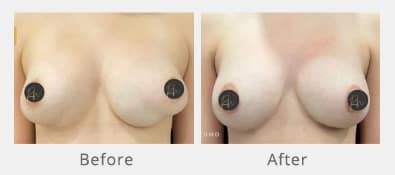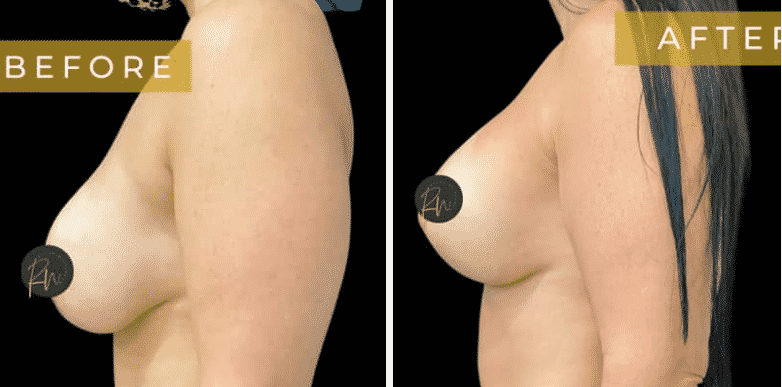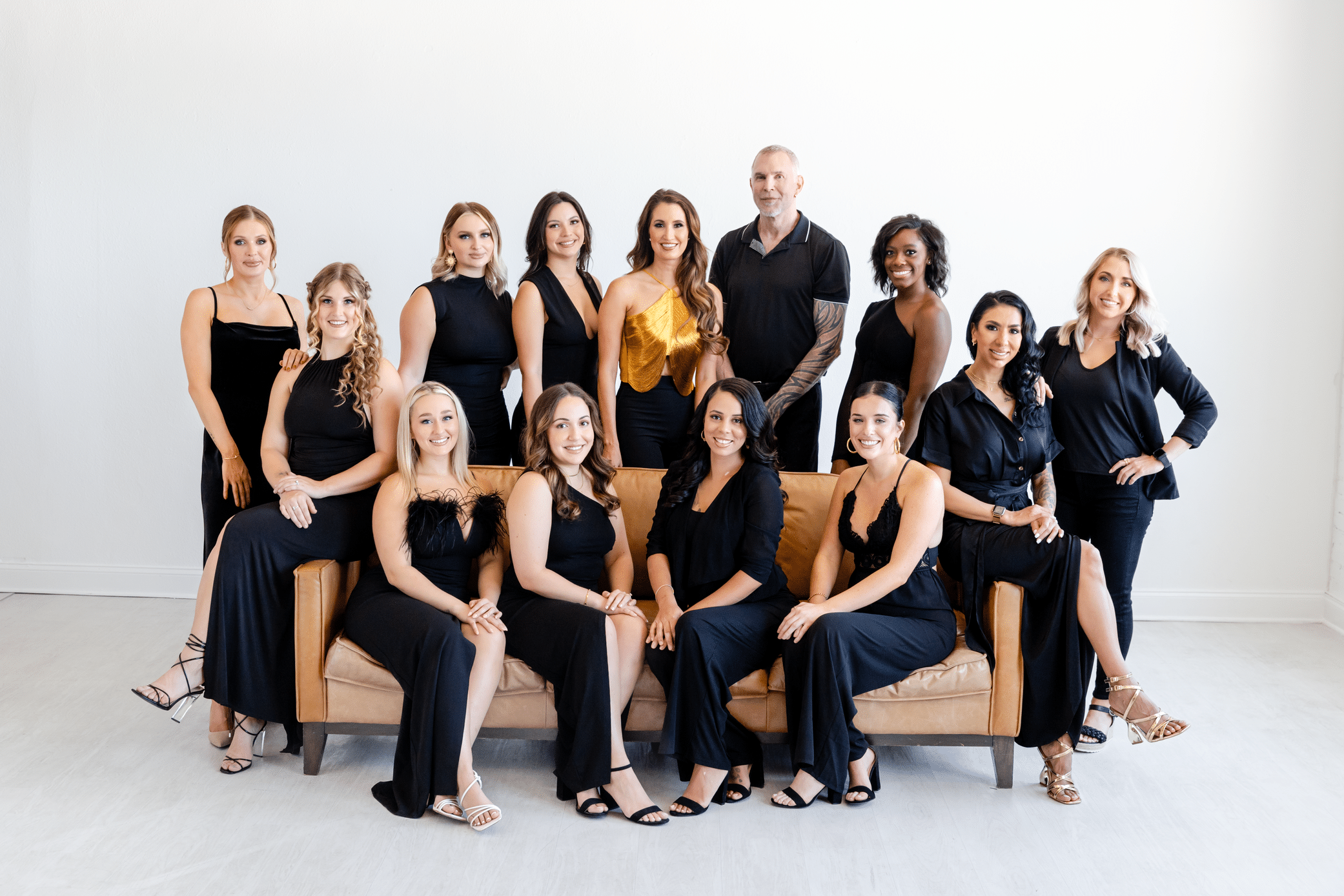Dr. Rachel Walker has extensive experience in breast procedures, including the correction of breast implant problems and complications. Breast revision surgery addresses a range of issues, from implant rupture and capsular contracture to cosmetic concerns like asymmetry or size changes. If you’re unhappy with your current implants for any reason, implant revision is always an option.
Call our office at 972-661-5077 for your breast revision and correction consultation with Dr. Walker in Dallas, Texas.
Click Images to View More Breast Revision/Correction Photo
Patient Review
“Dr. Walker is an amazing surgeon. She is very detail oriented, her bedside manner is excellent, and you can tell she truly cares about her patients. She is very thorough in her explanations and makes sure you understand.”
What Are the Main Reasons to Get Breast Implant Revision Surgery?
Overall, candidates for breast revision are typically seeking one of four things:
- Exchange of breast implant type
- Removal of breast implants
- Correction of unsatisfactory results of previous augmentation
- Replacement due to capsular contracture or deflation
The most common reasons patients request breast revision are functional issues, including capsular contracture, wrinkling, malrotation, or rupture of one or both implants.
The reason could also be cosmetic – you may want to exchange saline breast implants with silicone for a more natural texture and appearance, or you may want the breast implant removed altogether because you no longer like the look.
No matter what your reason is, Dr. Walker will walk you through the best approach to help you feel great about your decision.
How Is Breast Revision Surgery Performed?
Dr. Walker performs breast revision surgery under general anesthesia in an accredited surgical center. After your procedure, we monitor you until the anesthesia wears off, and then you'll be released to a loved one who can drive you home and help you get settled.
In most cases, Dr. Walker will use the same incision spots from your previous surgery. If you're also getting a breast lift, she may need to make new incisions according to your surgical plan.
Once you're comfortably anesthetized, Dr. Walker will carefully remove your old implants and replace them with new ones if that's what you chose during your consultation. If needed, she’ll adjust the implant pocket to correct any issues like capsular contracture.
After confirming the shape and position of your breasts is correct, Dr. Walker will close the incisions and apply a compression garment for swelling and discomfort. The entire procedure usually takes between one and two-and-a-half hours.
Recovery After Breast Implant Revision
Recovery from breast revision is similar to what you experience after your initial breast augmentation. You’ll have prescription pain medication for three to four days after the surgery.
During this time, it is important to rest and keep physical activity to a minimum. Walking is an approved activity that should be done a few times a day to prevent the formation of blood clots in the legs.
Beyond that, avoid lifting and moving objects using your arms, which will be outlined in your post-operative care instructions. Usually, patients are ready to return to work in one to two weeks, however, you’ll still need to avoid strenuous activities for six weeks post-op.
What to Expect From Your Results
After your breast revision surgery, you can expect improved breast shape and symmetry. Many patients see a more natural, balanced appearance. Remember that the healing process takes time – the initial swelling and settling of the implants can last several weeks or months. Your final results will become more apparent as the swelling subsides.
Due to the complex nature of breast revision surgery, Dr. Walker will spend a good deal of time with you discussing options and expected outcomes, all with the goal of setting realistic expectations for a satisfying outcome.
Correcting Complications From Large Implants
Some corrections simply involve expanding an incomplete pocket and replacing implants with a better size.
In other cases, breast revision requires a more complex approach, especially when dealing with over-dissected pockets or pockets that have stretched and become distorted by large implants. Larger implants tend to cause more tissue distortion and can lead to complications over time.
Corrective surgery may involve a combination of techniques, such as:
- Breast lifting to restore a natural position
- Skin tailoring to adjust for excess skin
- Downsizing implants to reduce strain on the tissue
- Internal modification of the pocket to reshape and tighten it
- Removal of internal scar tissue
These surgeries are often less predictable and may require patients to accept certain compromises, such as implant downsizing, in order to balance their appearance. Since each case is unique, a detailed consultation with Dr. Walker is essential to determine the best course of action for your specific situation.
Why Choose the Plastic Surgery Center of Dallas?
The Plastic Surgery Center of Dallas is led by board-certified plastic surgeon Rachel Walker, MD. Dr. Walker is a detail-oriented surgeon who takes the utmost care in performing revision procedures. Her training and skill combine to achieve excellent results that support optimal breast shape for each patient.
Our AAAASF-accredited surgical suite combines the advanced equipment of a hospital operating room with the convenience and privacy of an office setting, making it the perfect choice for your breast revision surgery.
Is Breast Revision Painful?
The surgery itself will not be painful. Recovery from your breast revision surgery may be shorter and less painful than what you experienced after your initial surgery, depending on the specifics of your procedure. Expect to feel swollen and sore at first. Your incisions will be dressed, and you may be placed in a support garment.
Remember not to rush the recovery process; patience is key to getting the best outcome.
Will My Breast Revision Cause More Scarring?
Dr. Walker carefully plans each breast revision to minimize additional scarring. In most cases, she uses the same incisions from your previous surgery to avoid creating new scars. However, if your revision includes a breast lift or other adjustments, additional incisions may be needed, which could result in new scars.
That said, Dr. Walker takes special care to place incisions in areas where scars will be less noticeable. Over time, with proper care, your scars should fade and become less visible.
How Long After My Initial Breast Augmentation Should I Wait Before Considering Breast Revision?
Generally, you should wait at least six to 12 months after your initial breast augmentation before you consider a revision. This waiting period allows ample time for your body to heal and the implants to settle into their final position.
During this time, any swelling or changes in breast shape will subside and give you a clearer idea of the final results. Then, you can make a more informed decision about whether or not you want a revision.

What Are the Risks Associated With Breast Revision Surgery?
Breast revision surgery, like any procedure, comes with some risks, including:
- Infection
- Scarring, which can vary in visibility
- Implant rupture or deflation
- Changes in nipple or breast sensation
- Capsular contracture (scar tissue around the implant)
Dr. Walker will explain these risks during your consultation and take the necessary steps to mitigate them.
Can I Switch From Silicone to Saline Implants During a Revision Surgery?
Yes, you can switch from silicone to saline implants during a revision surgery. Many women choose to change the type of implant for various reasons, including:
- Personal preference
- The feel of the implants
- Medical concerns
During your consultation, Dr. Walker at the Plastic Surgery Center of Dallas will discuss the benefits and potential drawbacks of each type of implant.
How Do I Choose the Right Size and Type of Implant for My Revision?

Choosing the right size and type of implant for your breast revision can be daunting. This decision involves several factors, including:
- Your body type
- Your skin elasticity
- Your existing breast tissue
- Your aesthetic goals
- Issues experienced with your initial implants (such as rupture or capsular contracture)
Dr. Walker will use this information to recommend implant sizes and types that will provide the best results. She will listen carefully to your concerns and help you make the right choice for your needs and preferences.
Can Breast Revision Fix Issues Caused by Weight Fluctuations After My Initial Surgery?
Yes, breast revision surgery can address issues caused by weight fluctuations. Significant weight changes can affect how your breasts look and cause problems like:
- Asymmetry
- Sagging
- Changes in implant position
During a breast revision, Dr. Walker can correct these issues by repositioning the implants. She can also adjust their size or incorporate a breast lift if necessary.
What Is the Difference Between Breast Revision and Breast Reconstruction?
Breast revision and breast reconstruction are distinct procedures with different objectives.
Breast revision is performed to correct or improve the results of a previous breast augmentation. This might involve changing implant size or type, addressing complications, or improving aesthetic outcomes.
On the other hand, breast reconstruction is typically performed after a mastectomy or injury to rebuild the breast. This procedure aims to restore the breast’s appearance, often using implants or tissue from other parts of the body.
How Long Do the Results of Breast Revision Surgery Last?
The results of breast revision surgery can last for many years, but the longevity of your results depends on several factors, including:
- Implant type and quality: Modern implants are durable and long-lasting, but they are not designed to last a lifetime. You may need additional revisions in the future if issues arise.
- Your body: Weight fluctuations, pregnancy, and aging can all impact the appearance of your breasts over time.
- Surgical technique: Dr. Walker’s advanced techniques and attention to detail help create lasting results.
While breast implants typically last 10-20 years, some patients may never require another revision, while others may need future adjustments depending on their body's changes or personal preferences.
Long-Term Maintenance After Breast Revision
To preserve your breast revision results, attend regular checkups with Dr. Walker. Maintaining a stable weight and a healthy lifestyle helps prevent changes in breast shape. Keep an eye on your implants for any signs of complications, such as discomfort or changes in appearance, and follow your routine self-exams and mammogram schedule to make sure your implants and breast tissue stay in good condition.
Can Breast Revision Surgery Be Combined With Other Procedures?
Yes, breast revision can be combined with other procedures, such as a breast lift to correct sagging, liposuction for body contouring, or a tummy tuck for a more comprehensive transformation. Fat grafting is also an option to enhance breast volume.
Dr. Walker will work with you to create a personalized plan, allowing you to achieve multiple aesthetic goals in one surgery.
Call Dr. Walker for Breast Revision & Implant Correction in Dallas!
If you have questions about breast revision surgery or you feel ready to move forward with the procedure, do not hesitate to book a personalized consultation with Dr. Rachel Walker. Call 972-661-5507 or use our email contact form. Our office is located in Dallas, TX, and we look forward to serving you!
Resources:
- Read the article “More Choices, Great Results“
- Read the article “Breast Augmentation: Myths and Truths“
- Read about the various Pain Management Options we provide
- Learn more about our innovative simulator tool, Vectra 3D, to further assist you and the doctor during your consultation.






